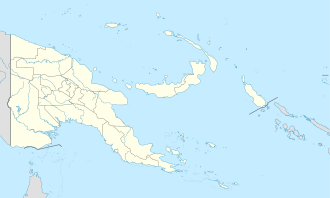History
Japanese called Los Negros Island the Hyane Island and had built some facilities on the two islands. [5] Manus Island was picked for a major air and sea base as it was near Empire of Japan strong points: 387 miles to Rabaul, 694 miles to Truk, 273 miles Kavieng and 244 miles to Wewak. The other reason was Manus Island's Seeadler Harbor, which offered the largest and most protected Southwest Pacific fleet anchorage.
By March 1944 the beaches were secured enough that the Seabees started construction. The first airfield captured was Hyane Airfield which was renamed Momote Airfield. While the airfield was captured the outlining area still had fighting and the airfield was attacked two times while under construction. Hyane Airfield has one 4,000-foot runway in poor condition. On March 10, fighter planes began using the Momote Airfield. Seabees completed all Momote Airfield construction and improvements on June 1, 1944 and turned the 7,800-feet runway Momote Airfield over to the United States Army Air Forces. The newly built air base had a camp, 90 fighters and 80 bombers, a tank farm with 17,000-barrel aviation gasoline that was filled from a small T1 tanker harbor and an ammunition depot. On April 1, 1944 Seabees started construction at Mokerang Airfield on Los Negros Island with the US Army engineers. The existing runway was improved to 8,000 feet and a new second 8,000 feet runway was built. Built at Mokerang Airfield were: a base camp, supply depot, repair depot, and a 30,000-barrel tank farm.
At Hyane Harbor Seabees constructed a 500-bed evacuation hospital for the US Army. For the US Navy, at Hyane Harbor Seabees built a waterfront complex: two cargo ship wharves, a repair pier, 800-foot ship refueling pier, and a ship unloading and repair crane. Also starting on June 19, 1944, at Hyane Harbor was a pontoon assembly depot, as it was found that shipping pontoon flat, unassembled took a lot less space in ships. The pontoon depot had a personnel camp and warehouses. For the US Army and Navy a large aviation supply depot was built. For the Navy a 5,000 runway was built and a 7,000-barrel aviation-gasoline tank farm. To support the activity at Hyane Harbor a small-boat repair depot and camp was built. As the built up in the Pacific continued in April 1944, two new camp constructions were started on Los Negros Island: Papitalai Point and one at Lombrum Point. At Papitalai Point Seabee 58th Battalion built a base camp, depot, a PT boat overhaul base, fuel oil and diesel tank farm. Seabee started work at Lombrum Point on April 17, 1944, which become Lombrum Naval Base. At Lombrum Point Seabee built seaplane repair base, a ship repair base, and a Landing craft repair base. Each base required the building of camps, depots, piers and shops. Landing craft base supported LCT, LSM, and a host of smaller landing craft. For ship repair, different sized Auxiliary floating drydocks were towed to the base. The largest USS AFDB-2 and USS ABSD-4 were able to drydock battleships.
Also at Lombrum Point Seabee built a seaplane base with a concrete seaplane ramp and 8,000-barrel tank farm. At the captured coastal Lorengau Airfield a large supply depot was built. Lorengau Airfield was a 3,500-foot grass runway and due to lack of space, it was not improved, but a support camp and depot was built at the Lorengau Airfield. Navy Base headquarters was built at Lorengau, near the mouth of Lorengau River. At the Lorengau Navy Base Seabee built a 1,000-bed Navy Hospital 15. The headquarters also had a camp for 5,000 men incoming Troops. Pityilu Airfield, on Pityilu Island was built to support aircraft carriers, with a training center and storage of 350 spare fighter planes for later aircraft carrier use. Ponam Airfield on Ponam Island was also built to support aircraft carrier fighter planes.
After the war, most bases were abandoned in 1946 and 1947. Momote Airfield became Momote Airport. Some bases were turned over to the Royal Australian Navy and later to the Papua New Guinea Defence Force. [2] [3] [6] [7]
This page is based on this
Wikipedia article Text is available under the
CC BY-SA 4.0 license; additional terms may apply.
Images, videos and audio are available under their respective licenses.




























